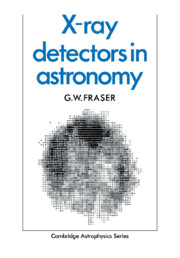Book contents
- Frontmatter
- Contents
- Preface
- Acknowledgements
- Units and constants
- 1 Observational techniques in X-ray astronomy
- 2 Proportional counters
- 3 Microchannel plates
- 4 Semiconductor detectors
- 5 Scintillators, phosphors and NEADs
- 6 Single photon calorimeters
- Appendix A Observational X-ray astronomy: a bibliography
- Appendix B X-ray data analysis techniques
- References
- Index
- Frontmatter
- Contents
- Preface
- Acknowledgements
- Units and constants
- 1 Observational techniques in X-ray astronomy
- 2 Proportional counters
- 3 Microchannel plates
- 4 Semiconductor detectors
- 5 Scintillators, phosphors and NEADs
- 6 Single photon calorimeters
- Appendix A Observational X-ray astronomy: a bibliography
- Appendix B X-ray data analysis techniques
- References
- Index
Summary
Introduction
Gas proportional counters have been the ‘workhorses’ of X-ray astronomy throughout the subject's entire history. The roots of proportional counter development, however, go back much further, to the pioneering counters of Rutherford and Geiger (1908), to the first quantitative gas ionisation studies of J. J. Thomson (1899) and beyond.
The physics of gas-filled particle and X-ray detectors was very intensively researched during the four decades up to 1950. The classic texts of Curran and Craggs (1949), Rossi and Staub (1949) and Wilkinson (1950) describe a highly developed field at the zenith of its importance: before first Nal scintillators (in the 1950s) and then semiconductor detectors (in the early 1960s) replaced gas detectors in many areas of nuclear physics research.
Outside X-ray astronomy, proportional counter fortunes began to revive in the late 1960s when position-sensitive variants of the single-wire proportional counter (SWPC) were introduced as focal plane detectors for magnetic spectrographs (Ford, 1979). Multi-wire detectors (first developed, but not fully exploited, at Los Alamos as part of the Manhattan Project – Rossi and Staub, 1949) then rapidly evolved to provide an imaging capability in two dimensions over large areas. Here, the impetus was provided by the particle physicists (Charpak et al, 1968) who continue to dominate the field of gaseous detector development.
This chapter does not attempt to give a complete account of gaseous electronics, nor does it describe in detail related detector developments in fields such as particle physics (Fabjan and Fischer, 1980; Bartl and Neuhofer, 1983; Bartl et al, 1986).
- Type
- Chapter
- Information
- X-ray Detectors in Astronomy , pp. 35 - 115Publisher: Cambridge University PressPrint publication year: 1989

